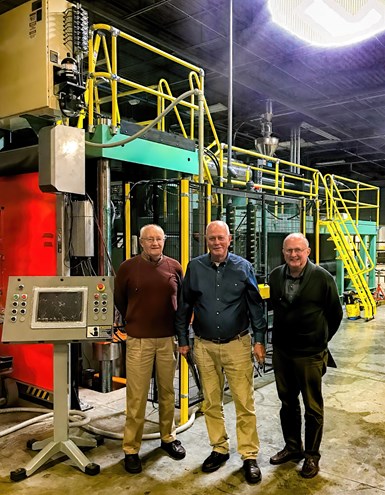Structural Foam Goes Vertical—Again!
A new generation of vertical presses takes structural foam back to its origins—but with a big shot of new enhancements.
Like the 1980s DeLorean sports car that morphed into a time-traveling aircraft, structural-foam presses have gone “back to the future” and emerged transformed. Wilmington Machinery recently built a pair of vertical-clamp structural-foam (SF) presses for a U.S. customer that wanted the advantages of vertical presses, not least of which is that two of them can fit in the same floorspace as one comparably sized horizontal machine. According to Russ La Belle, Wilmington’s founder and president, vertical machines also have the advantage of easier mold installation and removal, and tool costs are reduced by using gravity to reduce the guidance requirements for the ejection system in comparison with a horizontal machine.
So why were these two new presses, in La Belle’s estimation, the first vertical SF units built by anyone in the last 20-25 years? He remembers the first SF machines, built to a design from Union Carbide, which owned the original patents to the process. Those were all vertical presses, but they were very slow, by today’s standards, as well as inflexible and inefficient.
Renewing an Old Concept
Built to mold enclosures, the two vertical Wilmington presses have 500-ton clamps, platen sizes of 102 × 72 in., tiebar clearance of 90 × 56 in., clamp stroke of 78 in., and max. open daylight of 102 in. More notable is their shot capacity of 125 lb, which La Belle thinks is much larger than for any vertical press ever built before—“That’s large for any structural-foam press,” he says.

Over 100 years of experience: L. to R.: Wilmington’s Ken Bealer, chief mechanical engineer; Russ La Belle, president; and John Allred, v.p. of technology, beside a new vertical press.
Whereas the older vertical SF machines had a single row of nozzles, Wilmington’s update of that design has a square array of more than 100 possible locations for up to 20 shutoff nozzles, each one filled independently by Wilmington’s Versafil injection system, which sequences the mold fill and provides individual shot control. These more versatile presses each can mount up to six molds with up to 20 cavities—or one large mold with sequential nozzle control.
The new vertical SF presses have energy-saving servohydraulic drive and Allen-Bradley PLC controls. They also have a more efficient layout that provides a much shorter melt path from the injection barrel to the mold. La Belle explains, “In the old days, the injection unit sat on the floor, with a 12-ft melt pipe to get material to the mold. Our new presses have elevated extruders with the hydraulics underneath.” Also mounted beneath the two-stage screw/plunger injection unit are twin gas accumulators.
La Belle adds that the presses were part of a turnkey service that included designing the pits, machine installation, and startup.
Related Content
-
Scaling Up Sustainable Solutions for Fiber Reinforced Composite Materials
Oak Ridge National Laboratory's Sustainable Manufacturing Technologies Group helps industrial partners tackle the sustainability challenges presented by fiber-reinforced composite materials.
-
New Facility Refreshes Post-Consumer PP by Washing Out Additives, Contaminants
PureCycle prepares to scale up its novel solvent recycling approach as new facility nears completion.
-
New Screw Boosts Mixing, Enhances Polymer Properties
Device mixes at the ‘molecular level,’ inventor says, to boost mechanicals and in some cases make pre-drying redundant.
















